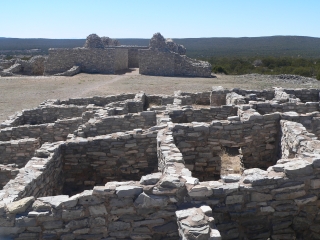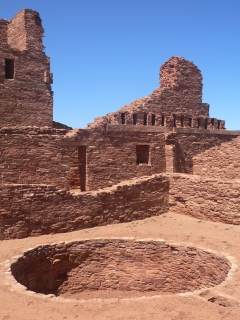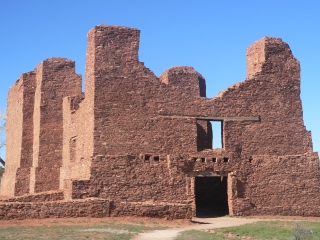near Mountainair, N.M.
NPS Website; Local Website
The ruins of three imposing 17th Century Spanish colonial missions accompanied by the extensive ruins of large Pueblo towns.
BEAUTY (7/10)
Clear blue skies make it hard not to rank any southern New Mexican site high. The white stone structures of Gran Quivira are as striking as the red walls of Abó and Quarai. All three excavated ruins display elements of Spanish Colonial and Puebloan architecture – at times coexisting in the next to each other, other times built on top of one another, struggling to hold dominance over the same space.
Each ruin allows visitors to walk into the remains of its mission church. Feel the chill that comes from the stone floors of Gran Quivira and Quarai. Look up at the high walls and bell towers. Built from the same raw material and placed just yards away, the church is very different than the flat, low village pueblos that surround it. Contrast both with the sunshine and rolling hills behind them and you have some great photo ops.
HISTORICAL INTEREST (7/10)
Before the arrival of the Spanish, people of the Salinas Valley prospered as agricultural communities located at a trading crossroads. Juan Onate is credited with naming the area after one of its primary resources: salt.
At first, Salinas Valley Puebloans welcomed the arrival of Franciscan missionaries and the modern tools and farming techniques they offered. But as more and more Spanish settled the area, the original inhabitants found themselves pawns in a constant power struggle between church and state, both expecting labor and loyalty.
Overburdened by conflicting demands of the Franciscan missionaries and the Spanish Governor and encomenderos, further weakened by years of drought and Apache raids, inhabitants of the Salinas pueblos completely abandoned the area by the late 1670s and were absorbed by tribes along the Rio Grande.
The Salinas Valley is the setting for one of the most effective Puebloan revolts in history. The 1680 revolt, an effort which united all of the remaining pueblos surrounding the Salinas missions, left over 400 Spanish settlers dead. Spanish that survived also abandoned the Salinas Valley.
CROWDS (7/10)
A dozen or so visitors ambled through each site. License plates were from all over. At the Mountainair VC, we shocked one man from Marquette, Michigan with our knowledge of his hometown. The day was filled with friendly exchanges.
Is it possible to visit all three missions as a day trip from Albuquerque? Well, we did but you need to get an early start. The map on the Park’s brochure is specific and very helpful once you can get your hands on it.
The Abó Ruins Site is 66 miles southeast of the Duke City via Interstate 25 to New Mexico Route 47 to U.S. Route 60. The Salinas Pueblo Mission NM Visitor Center in Mountainair, N.M. is nine miles east of Abó, still on U.S. Route 60.
From here you have a choice. The Gran Quivira Ruins is 25 miles to the south on N.M. Route 55. If you do not have enough time, the Quarai Ruins Site is 8 miles north of Mountainair, also on N.M. Route 55. Albuquerque is 64 miles northwest of Quarai, via Route 55, N.M. Route 337 and finally Interstate 40. That scenic path will take you through the mountains of rural New Mexico and the interestingly named towns of Tajique, Chilili and Escobosa.
Well worn dirt paths at all three ruins take you through the old missions and pueblos.
CONCESSIONS/BOOKSTORE (4/5)
All four Visitor Centers stock a terrific selection of Site-specific books. A great proportion of their titles revolve around New Mexican missions, 17th Century Spanish history, the clash of cultures and the 1680 uprising. Michael loves books like The Place Names of New Mexico on sale at Abó. Is the city of Albuquerque named for the Latin words for white oak, quercus alba or the Arabic word for plum, al barquq. Hard to say.
COSTS (4/5)
Admission is completely free.
RANGER/GUIDE TO TOURIST RATIO (5/5)
We had expected the NHP to consist of one main Visitors Center in Mountainair and three free standing ruins. Small Ranger Stations (with Rangers!) at each mission pleasantly surprised us. There were no scheduled Ranger-led tours, but the Ranger at Quarai told us he was happy to walk through the ruins with visitors on request.
TOURS/CLASSES (7/10)
The four visitor centers all have unique Museums that cover subtly different ground. The Abó Museum takes a timeline through the Spanish occupation and places a strong emphasis on the absolute differences in worldviews and philosophies shared by the invaders and the longtime inhabitants.
The recently produced introductory video shows at the Mountainair Visitor Center. It gives a nice overview mixed with fancy cinematography. Mountainair also showcases a fascinating 17th Century Spanish poster that shows the definer attached to children of racially-mixed parents. Mestizo, Castizo, Espanyol. Mulato, Canbujo, Cribaro and Albarazado are just a few of these names. They all have specific (and what had to be confusing) definitions.
The Gran Quarai Museum emphasizes pottery that was excavated on site. Don’t miss the crossbeam hanging above the Ranger desk, it is the original wood piece from the short-lived Gran Quarai church. The Quarai Museum recounts the often-tempestuous relationship between the Spanish secular settlers and the Spanish Catholic priests. Both had different ideas on the role the Natives should play.
The small Museums provide a relaxed and effective learning experience. Their size allows you to delve in depth into a Mission’s specific topic and digest its meaning. The next Mission gives you a different but interrelated subject.
FUN (7/10)
We always have fun at Missions. Did we just say that? The church ruins are tremendous, soaring to heights unthinkable in such a barren country. They all stand within a stones throw of Ancestral Puebloan kivas, the Native spiritual centerpiece. The kivas go down, worship literally occurs inside the earth. The churches rise towards the heavens, beckoning God from above. It is no wonder that the Spanish conversion attempts were less than successful.
Because the Salinas Valley was abandoned for so long, the missions and the pueblos are very well preserved. Wake up early and visit the Salinas Pueblo Missions NHP on a sunny day. You can make it back to Albuquerque in time for a nice dinner. We recommend trying to see all three Sites since they each have their own histories. Unfortunately, they all share the same tragic end.
TOTAL 57/80
www.usa-c2c.com
© 2005